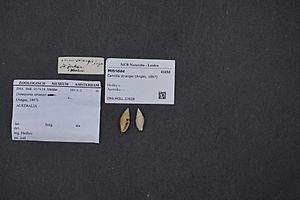Roseomitra strangei facts for kids
Quick facts for kids Roseomitra strangei |
|
|---|---|
 |
|
| Shell of Roseomitra strangei (specimen at Naturalis Biodiversity Center) | |
| Scientific classification | |
| Synonyms | |
|
Roseomitra strangei is a fascinating type of sea snail. These amazing creatures are marine gastropods, which means they are a kind of mollusk that moves on a "stomach-foot." They belong to the Mitridae family, often called miter snails because their shells sometimes look like a bishop's miter hat.
Contents
Discovering Roseomitra strangei
This particular sea snail was first officially described in 1867 by a scientist named Angas. When a new species is found, scientists give it a special two-part name, like Roseomitra strangei. This helps everyone around the world know exactly which creature they are talking about.
What Does Roseomitra strangei Look Like?
The shell of Roseomitra strangei is quite unique. It often has a beautiful shape, typical of miter snails. The shell shown in the picture gives us a good idea of its size and patterns. Sea snail shells are made of calcium carbonate and grow as the snail gets bigger.
Shell Features
- Shape: The shell is usually tall and somewhat narrow.
- Surface: It might have ridges or bumps, which can help protect the snail.
- Opening: The opening where the snail comes out is called the aperture.
Where Does Roseomitra strangei Live?
This marine snail is found only in one special place: New Zealand. When a species lives only in one specific area, it is called endemic to that region. This means you won't find Roseomitra strangei naturally anywhere else in the world!
Habitat of Sea Snails
Sea snails like Roseomitra strangei live in the ocean. They are often found on the seabed, sometimes in shallow waters near the coast or deeper down. Their habitat provides them with food and protection from predators.
Life in New Zealand Waters
New Zealand's waters are home to many unique marine animals. The ocean environment there provides the perfect conditions for Roseomitra strangei to thrive. They are an important part of the local marine ecosystem.
Images for kids


